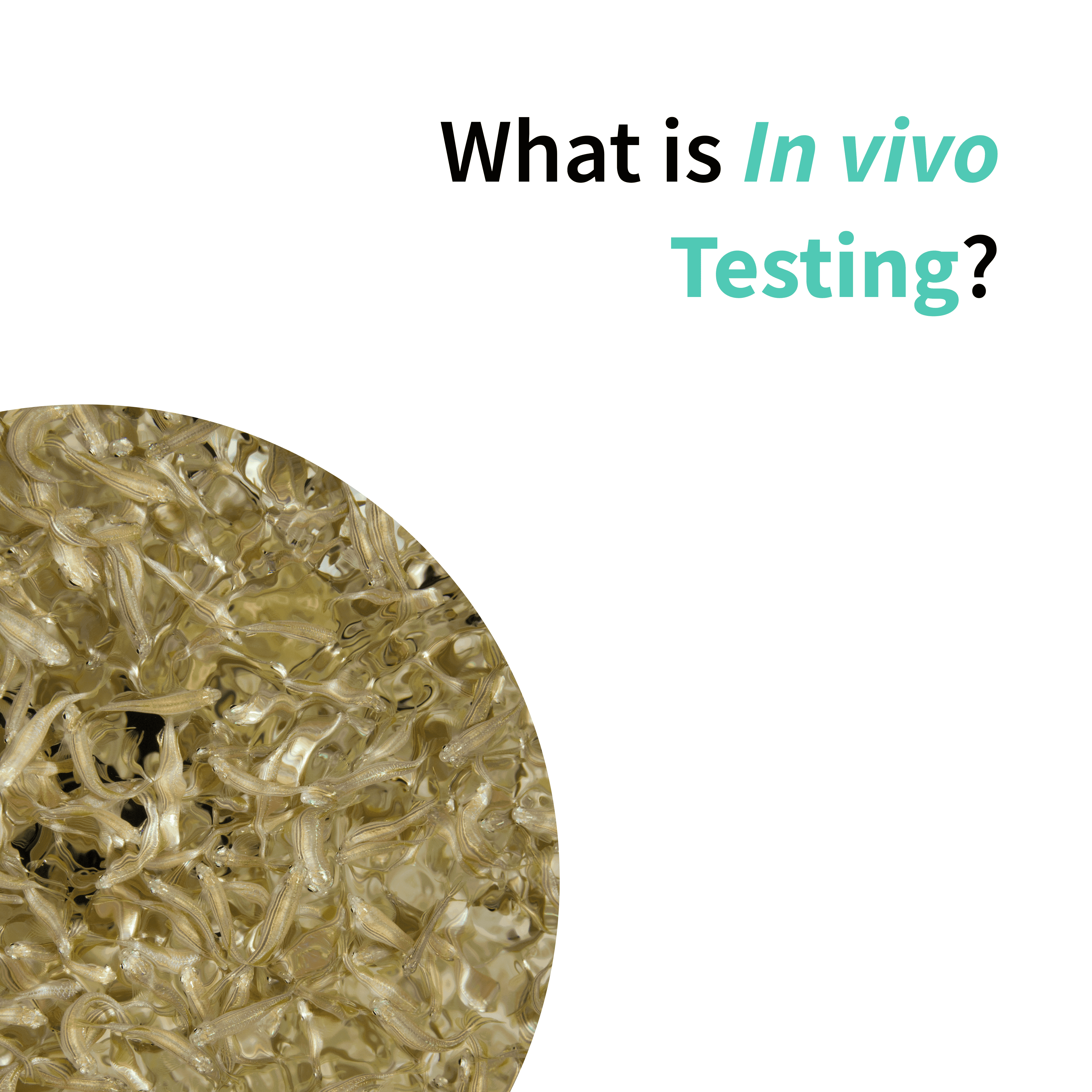What is in vivo testing?
The Drug Discovery and Development process is long and goes through several phases, often taking over decades. The process includes different in vitro and in vivo testings that allow to analyze the efficacy and toxicity of potential drug candidates.
The aspect that is most discussed today regarding drug testing is the use of animal models for in vivo studies. In this article, we will explain what is in vivo testing, the applications of assays in vivo, and how it differs from other screening methods. We will also explain why Zebrafish is considered a New Alternative Model (NAM) and its advantages in Drug Discovery and Development.
Definition of In Vivo Testing
In vivo testing, derived from the Latin "in living," refers to scientific experiments conducted within or on a living organism. In contrast to in vitro assays, which utilize isolated cells or tissues, in vivo tests are performed on a complete, living organism, such as plants, laboratory animals, and human participants, to assess the effects of a substance, treatment, or biological process under controlled conditions.
This comprehensive approach encompasses a wide range of applications, such as:
-
Biomedical research: in vivo models contributed significantly to advancing knowledge in biomedical sciences. They are used to study complex biological processes, such as metabolism, aging, and the immune response, under physiological conditions that closely resemble those in humans.
-
Understanding disease mechanisms: researchers can induce or manipulate animal genes to create in vivo models that mimic various human diseases. Studying these models provides an understanding of disease progression, the correlation between different biological factors, and the identification of potential therapeutic targets.
-
Safety assessments of chemicals and products: regulatory requirements often mandate in vivo testing to assess the safety of chemicals, household products, cosmetics (now banned in Europe by 1223/2009 regulation), and industrial materials. This helps identify potential hazards like carcinogenicity, teratogenicity, cardiotoxicity, or genotoxicity.
In Vivo Testing: A Phase of Drug Development
Once a potential drug candidate demonstrates effectiveness through a series of in vitro assays, in vivo testing can be performed to advance in future stages of the Drug Development process, linking Early Drug Discovery and progressing to clinical trials in humans. This phase is essential for evaluating potential therapeutic agents' efficacy, safety, and pharmacokinetics in humans (how a drug is absorbed, distributed, metabolized, and excreted in a living body).
Animal models, particularly mice, rats, and other rodents, are used extensively for in vivo testing during the preclinical Drug Discovery and Development phase due to their genetic similarities to humans. It is generally accepted because their implementation offers valuable means of predicting how a drug might interact within a living organism, including its potential benefits, and offers insight into the risk assessment of the molecule. This stage is critical, for example, for determining the dosing and route of administration before moving on to human trials.
Despite their undeniable utility, in vivo testing in Drug Discovery and Development faces several limitations and ethical considerations. One significant limitation is translating results from animal models to humans due to physiological, metabolism, and genetic differences. Many drugs that seem promising on in vivo tests fail in human trials because they do not exhibit the same efficacy or safety profile in humans.
Moreover, ethical implications about using animals and moral concerns about their welfare have led to increased regulatory monitoring and public pressure to find alternatives. It is estimated that approximately 20 million animal subjects are used for in vivo testing, although this practice has been banned for cosmetics. The ethical debate focuses on the 3Rs Principle—Replacement, Reduction, and Refinement of animals—aiming to replace animals with New Alternative Models (NAMs), reducing the number of animals used, and refining experiments to minimize their suffering. In response to those limitations and ethical challenges, there is a growing interest in developing, validating, qualifying, and utilizing NAMs that can offer highly predictive but ethically sustainable options for in vivo tests.
Zebrafish represent an innovative NAM that bridges the gap between traditional in vitro and in vivo testing methodologies in Research, Discovery, and Development. This distinction is based on the unique stage of zebrafish embryos before 5-6 days post-fertilization (dpf), during which they are not considered experimental animal models under European regulatory definitions. This aspect not only aligns with ethical needs to minimize animal use in scientific research but also takes advantage of the biological and practical benefits Zebrafish offers for chemical and drug testing.
Zebrafish has high genetic homology with humans (>70%), making it a compelling model for exploring human diseases and offering a predictive tool for assessing therapeutic candidates' potential toxicity, safety, and efficacy. Moreover, the transparency of embryos allows for direct observation of developmental processes and organs, and their small size allows the implementation of all the in vitro tools in an in vivo model. Combined with their rapid reproduction rate and relatively cost-effective maintenance, these characteristics make Zebrafish an attractive model for High Content Screening (HCS) of drug candidates. It can be used to study disease mechanisms, assess toxicity, and validate the efficacy of drugs, providing valuable insights with potentially higher translational relevance to humans than traditional rods.
Integrating Zebrafish as a New Alternative Model in Drug Discovery and Development can outline a new direction toward ethically sustainable and scientifically solid practices.
Sources
Fielden MR, Kolaja KL. The role of early in vivo toxicity testing in drug discovery toxicology. Expert Opin Drug Saf. 2008;7(2):107-10.
MacRae CA, Peterson RT. Zebrafish as tools for drug discovery. Nat Rev Drug Discov. 2015;14(10):721-31.
Patton EE, Zon LI, Langenau DM. Zebrafish disease models in drug discovery: from preclinical modelling to clinical trials. Nat Rev Drug Discov. 2021;20(8):611-628.
Zon LI, Peterson RT. In vivo drug discovery in the zebrafish. Nat Rev Drug Discov. 2005 Jan;4(1):35-44.



